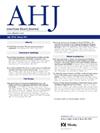Neonatal outcomes of pregnancy in women with congenital heart disease
IF 3.5
2区 医学
Q1 CARDIAC & CARDIOVASCULAR SYSTEMS
引用次数: 0
Abstract
Background
Infants born to women with congenital heart disease (CHD) are at increased risk for adverse outcomes compared with the general population. There are few large, contemporary studies examining the relationship between CHD severity, maternal risk factors and neonatal outcomes.
Methods
Data on women with CHD who had a live birth from 2011 through 2014 in geographic areas in Georgia, North Carolina and Utah were analyzed. Maternal CHD was identified from clinical and administrative data collected for the CDC Lifespan CHD surveillance project. CHD was categorized as severe and non-severe (shunt, valve or shunt+valve lesions). Linked birth certificates provided information on neonatal outcomes and neonatal, maternal and pregnancy characteristics. Neonatal outcomes included preterm delivery (<37 weeks), low birth weight (<2,500 grams), small for gestational age (SGA), neonatal intensive care unit (NICU) admission, a composite of any adverse outcome (one or more of preterm delivery, SGA or NICU admission), and CHD. Neonatal outcomes were summarized using descriptive statistics. Differences by maternal CHD severity were assessed using Wilcoxon rank-sum and Chi-square tests for continuous and categorical variables, respectively. The association of maternal and pregnancy characteristics (race, pregestational diabetes (PGDM), hypertensive disorders of pregnancy (HDP), prior preterm birth, non-singleton pregnancy, maternal age, previous living live birth and CHD severity) with neonatal outcomes were assessed using logistic regression fit using generalized estimating equations clustered on mother and adjusted for mother’s age, birth year and geographical location of delivery.
Results
Of the 2,411 liveborn infants born to 1,982 women with CHD (34% with severe CHD), 19% were preterm, 18% were of low birth weight, 14% were SGA and 4.2% were diagnosed with CHD. Of the included infants, 25% required NICU and 40% experienced the composite adverse outcome. Infants born to mothers with severe CHD (vs non-severe) were more likely to experience the composite adverse outcome (aOR 2.1 [1.8, 2.5]) and CHD recurrence (aOR 17.1 [9.3, 31.5]). In a multivariable analysis, severe CHD (vs non-severe, aOR 2.2 [1.8, 2.7]), Black race (vs White, aOR 1.8 [1.4, 2.3]), PGDM (aOR 2.5 [1.3, 5.0]), hypertensive disorder of pregnancy (aOR 2.1 [1.5, 3.1]), prior preterm birth (aOR 2.0 [1.3, 3.1]), and non-singleton pregnancy (aOR 6.7 [3.8, 11.6]) were associated with increased risk of the composite adverse outcome.
Conclusions
Nearly half of infants born to women with CHD experienced the adverse composite neonatal outcome, with the highest risk among those born to women with severe CHD. In addition to CHD severity, risk factors for adverse neonatal outcomes among women with CHD included black race, hypertensive disorders of pregnancy, PGDM, prior preterm birth and non-singleton pregnancy. These findings can help provide individualized counseling about neonatal risks for women with CHD.
先天性心脏病妇女妊娠的新生儿结局
背景:与一般人群相比,先天性心脏病(CHD)妇女所生婴儿发生不良后果的风险增加。关于冠心病严重程度、产妇危险因素和新生儿结局之间关系的大型当代研究很少。方法:分析2011年至2014年在乔治亚州、北卡罗来纳州和犹他州地理区域活产的冠心病妇女的数据。根据疾病预防控制中心终生冠心病监测项目收集的临床和管理数据确定产妇冠心病。冠心病分为严重和非严重(分流、瓣膜或分流+瓣膜病变)。关联出生证明提供了新生儿结局以及新生儿、产妇和妊娠特征的信息。新生儿结局包括早产(结果:在1982名冠心病妇女(34%为重度冠心病)的2411名活产婴儿中,19%为早产,18%为低出生体重,14%为SGA, 4.2%被诊断为冠心病。在纳入的婴儿中,25%需要新生儿重症监护病房,40%经历了综合不良结局。重度冠心病母亲所生的婴儿(与非重度冠心病母亲相比)更容易出现综合不良结局[aOR为2.1(1.8,2.5)]和冠心病复发[aOR为17.1(9.3,31.5)]。在一项多变量分析中,重度冠心病[与非重度相比,aOR为2.2(1.8,2.7)]、黑人[与白人相比,aOR为1.8(1.4,2.3)]、PGDM [aOR为2.5(1.3,5.0)]、妊娠高血压疾病[aOR为2.1(1.5,3.1)]、既往早产[aOR为2.0(1.3,3.1)]和非单胎妊娠[aOR为6.7(3.8,11.6)]与复合不良结局的风险增加相关。结论:近一半的冠心病女性所生的婴儿经历了不良的新生儿综合结局,其中重症冠心病女性所生的风险最高。除冠心病严重程度外,冠心病妇女不良新生儿结局的危险因素还包括黑人种族、妊娠期高血压疾病、妊娠期糖尿病、既往早产和非单胎妊娠。这些发现有助于为患有冠心病的妇女提供关于新生儿风险的个性化咨询。
本文章由计算机程序翻译,如有差异,请以英文原文为准。
求助全文
约1分钟内获得全文
求助全文
来源期刊

American heart journal
医学-心血管系统
CiteScore
8.20
自引率
2.10%
发文量
214
审稿时长
38 days
期刊介绍:
The American Heart Journal will consider for publication suitable articles on topics pertaining to the broad discipline of cardiovascular disease. Our goal is to provide the reader primary investigation, scholarly review, and opinion concerning the practice of cardiovascular medicine. We especially encourage submission of 3 types of reports that are not frequently seen in cardiovascular journals: negative clinical studies, reports on study designs, and studies involving the organization of medical care. The Journal does not accept individual case reports or original articles involving bench laboratory or animal research.
 求助内容:
求助内容: 应助结果提醒方式:
应助结果提醒方式:


